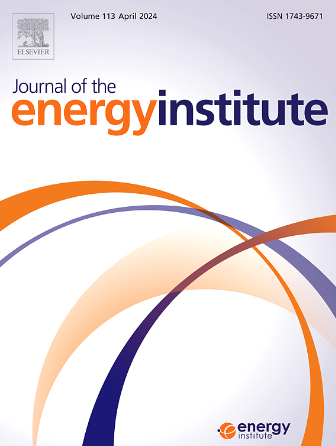进气温度和涡流比对氨/柴油双燃料发动机缸内燃烧和污染物形成特性影响的数值研究
IF 5.6
2区 工程技术
Q2 ENERGY & FUELS
引用次数: 0
摘要
为了提高氨燃料的燃烧效率,提高氨发动机的运行稳定性和排放水平,本研究基于 CONVERGE 软件构建了氨/柴油双燃料发动机缸内燃烧数值模型,研究了初始进气温度和漩涡强度对氨/柴油双燃料发动机缸内燃烧和污染物形成特性的影响。结果表明,提高进气温度可以改善缸内热气氛,推进双燃料燃烧反应过程,提高缸内燃烧压力和温度峰值。当进气温度从 303 K 提高到 343 K 时,缸内峰值压力从 6.05 MPa 提高到 6.44 MPa,从而有效改善了氨/柴油双燃料发动机的不完全燃烧排放。缸内未燃烧的 NH3、CO 和 HC 排放量分别减少了 20.2%、77.1% 和 88.21%。增加漩涡比可增强缸内气体扰动,减少附着在缸壁上的燃料量,并改善缸内燃料-气体混合物的质量。它还能加速可燃混合气的形成过程,提前氨燃料消耗的起点,加快初始反应速度。当漩涡比从 0.5 增加到 3.0 时,缸内未燃烧的 NH3 排放量减少了 14.85%。合理调节进气温度和涡流比有助于改善缸内直喷燃料颗粒的分布,从而优化双燃料燃烧过程,提高发动机性能。本文章由计算机程序翻译,如有差异,请以英文原文为准。
Numerical study on influences of intake temperature and swirl ratio on in-cylinder combustion and pollutant formation characteristics of ammonia/diesel dual-fuel engine
In order to improve the combustion efficiency of ammonia fuel, and enhance the operational stability and emission level for ammonia engines, this study constructs an in-cylinder combustion numerical model of ammonia/diesel dual-fuel engine based on CONVERGE software, and investigates the effects of initial intake temperature and swirl intensity on in-cylinder combustion and pollutant formation characteristics of ammonia/diesel dual-fuel engine. The results show that increasing the intake temperature can improve the in-cylinder thermal atmosphere, advance the dual-fuel combustion reaction process, and increase the peak in-cylinder combustion pressure and temperature. The peak in-cylinder pressure increases from 6.05 to 6.44 MPa when the intake temperature is increased from 303 to 343 K. This is effective in improving the emissions of incomplete combustion for the ammonia/diesel dual-fuel engine. The in-cylinder unburned NH3, CO and HC emissions are reduced by 20.2 %, 77.1 % and 88.21 %, respectively. Increasing the swirl ratio enhances the in-cylinder gas disturbance, reduces the amount of fuel attached to the wall, and improves the quality of in-cylinder fuel-gas mixture. It also accelerates the process of combustible mixture formation, advances the starting point of ammonia fuel consumption, and accelerates the initial reaction rate. When the swirl ratio is increased from 0.5 to 3.0, the in-cylinder unburned NH3 emission is reduced by 14.85 %. Reasonable adjustment of intake temperature and swirl ratio helps to improve the distribution of direct injection fuel particles inside the cylinder, thereby optimizing the dual-fuel combustion process and enhancing engine performance.
求助全文
通过发布文献求助,成功后即可免费获取论文全文。
去求助
来源期刊

Journal of The Energy Institute
工程技术-能源与燃料
CiteScore
10.60
自引率
5.30%
发文量
166
审稿时长
16 days
期刊介绍:
The Journal of the Energy Institute provides peer reviewed coverage of original high quality research on energy, engineering and technology.The coverage is broad and the main areas of interest include:
Combustion engineering and associated technologies; process heating; power generation; engines and propulsion; emissions and environmental pollution control; clean coal technologies; carbon abatement technologies
Emissions and environmental pollution control; safety and hazards;
Clean coal technologies; carbon abatement technologies, including carbon capture and storage, CCS;
Petroleum engineering and fuel quality, including storage and transport
Alternative energy sources; biomass utilisation and biomass conversion technologies; energy from waste, incineration and recycling
Energy conversion, energy recovery and energy efficiency; space heating, fuel cells, heat pumps and cooling systems
Energy storage
The journal''s coverage reflects changes in energy technology that result from the transition to more efficient energy production and end use together with reduced carbon emission.
 求助内容:
求助内容: 应助结果提醒方式:
应助结果提醒方式:


